Effects of Water-to-Cement Ratio on Pore Structure Evolution and Strength Development of Cement Slurry Based on HYMOSTRUC3D and Micro-CT
Abstract
1. Introduction
2. Materials and Methods
2.1. Materials
2.2. Experimental Analysis Methods
2.2.1. Compressive Strength Analysis
2.2.2. Fractured Surface Morphology
2.2.3. Pore Structure Analysis
2.3. Establishment of Hydration Kinetics Model of Cement Slurry with HYMOSTRUC3D
3. Results and Discussion
3.1. Compressive Strength
3.2. Capillary Porosity
3.3. Pore Structure Evolution
3.4. The Relationship between Compressive Strength and Capillary Porosity
3.5. SEM Findings
4. Conclusions
- The simulated compressive strength and capillary porosity using the cement slurry hydration kinetics model established on HYMOSTRUC3D demonstrated a good agreement with the experimentally measured data, where the relative errors between the simulated results and measured results are within 0.6%~10.7% and 13.04~25.31% respectively.
- With the increase in the w/c ratio, the volume content of hydration products and the compressive strength decreases, while the volume of pores and capillary porosity increases.
- The compressive strength of cement stone is negatively correlated with capillary porosity. Capillary porosity is the main factor affecting the compressive strength of cement stone. In the well cementing industry, a lower w/c ratio should be selected as far as possible to prepare cement slurry and thus improve the early mechanical properties of the cement sheath.
- The mathematical relationship between the measured capillary porosity and compressive strength of cement slurry is well fitted by the Balshin function (R2 = 0.95), Ryshkewitch function (R2 = 0.94), Schiller function (R2 = 0.96), and the linear function (R2 = 0.95). Those mathematical functions can be used to characterize and predict the quantitative relationship between the compressive strength and capillary porosity of cement stone. Those findings have a certain application prospect in the fields of well cementing, meanwhile, it can help to improve the accuracy of the model established on HYMOSTRUC3D.
- The effects of the w/c ratio should be considered in building a broader mathematical function of the w/c ratio, porosity, and compressive strength.
Author Contributions
Funding
Institutional Review Board Statement
Informed Consent Statement
Data Availability Statement
Acknowledgments
Conflicts of Interest
References
- Liu, C.J.; Huang, B.Z.; Xu, T.T. Cement Injection Theory and Application in Oil and Gas Wells; Petroleum Industry Press: Beijing, China, 2001. [Google Scholar]
- Kremieniewski, M. Recipe of lightweight slurry with high early strength of the resultant cement sheath. Energies 2020, 13, 1583. [Google Scholar] [CrossRef]
- Tang, J.; Zhang, C.; Zhang, B.; Fangfang, S.H.I. Cement bond quality evaluation based on acoustic variable density logging. Pet. Explor. Dev. 2016, 43, 514–521. [Google Scholar] [CrossRef]
- Brandão, N.B.; Roehl, D.; de Andrade Silva, F.; e Silva, R.R. The impact of cement slurry aging creep on the construction process of oil wells. J. Pet. Sci. Eng. 2017, 157, 422–429. [Google Scholar] [CrossRef]
- Li, M.; Deng, S.; Yu, Y.; Jin, J.; Yang, Y.; Guo, X. Mechanical properties and microstructure of oil well cement stone enhanced with Tetra-needle like ZnO whiskers. Constr. Build. Mater. 2017, 135, 59–67. [Google Scholar] [CrossRef]
- Saleh, F.K.; Teodoriu, C.; Sondergeld, C.H. Investigation of the Effect of Cement Mixing Energy on Cement Strength and Porosity using NMR and UPV methods. J. Nat. Gas Sci. Eng. 2019, 70, 102972. [Google Scholar] [CrossRef]
- Mohamadian, N.; Ramhormozi, M.Z.; Wood, D.A.; Ashena, R. Reinforcement of oil and gas wellbore cements with a methyl methacrylate/carbon-nanotube polymer nanocomposite additive. Cem. Concr. Com. 2020, 114, 103763. [Google Scholar] [CrossRef]
- Visschedijk, A.J.; Denier van der Gon, H.A. Methane and ethane emission scenarios for potential shale gas production in Europe. Adv. Geosci. 2018, 45, 125–131. [Google Scholar] [CrossRef]
- Cleland, K.D.J. Assessment of the durability of concrete from its permeation properties: A review. Constr. Build. Mater. 2001, 15, 93–103. [Google Scholar]
- Schulze, J. Influence of water-cement ratio and cement content on the properties of polymer-modified mortars. Cem. Concr. Res. 1999, 29, 909–915. [Google Scholar] [CrossRef]
- Rao, G.A. Role of water–binder ratio on the strength development in mortars incorporated with silica fume. Cem. Concr. Res. 2001, 31, 443–447. [Google Scholar] [CrossRef]
- Rahmani, K.; Rahmanzadeh, B.; Piroti, S. Experimental study of the effect of water-cement ratio on compressive strength, abrasion resistance, porosity and permeability of nano silica concrete. Frat. Ed. Integrità Strutt. 2018, 12, 16–24. [Google Scholar] [CrossRef]
- Li, L.; Zhang, H.; Guo, X.; Zhou, X.; Lu, L.; Chen, M.; Cheng, X. Pore structure evolution and strength development of hardened cement paste with super low water-to-cement ratios. Constr. Build. Mater. 2019, 227, 117108. [Google Scholar] [CrossRef]
- Odler, I.; Robler, M. Investigations on the relationship between porosity, structure and strength of hydrated Portland cement pastes. II. Effect of pore structure and of degree of hydration. Cem. Concr. Res. 1985, 15, 401–410. [Google Scholar] [CrossRef]
- Odler, I.; Abdul-Maula, S. Investigations on the relationship between porosity structure and strength of hydrated portland cement pastes III. Effect of clinker composition and gypsum addition. Cem. Concr. Res. 1987, 17, 22–30. [Google Scholar] [CrossRef]
- Li, Y.X.; Chen, Y.M.; Wei, J.X.; He, X.Y.; Zhang, H.T.; Zhang, W.S. A study on the relationship between porosity of the cement paste with mineral additives and compressive strength of mortar based on this paste. Cem. Concr. Res. 2006, 36, 1740–1743. [Google Scholar] [CrossRef]
- Ozturk, A.U.; Baradan, B. A comparison study of porosity and compressive strength mathematical models with image analysis. Comput. Mater. Sci. 2008, 43, 974–979. [Google Scholar] [CrossRef]
- Ibrahim, A.; Mahmoud, E.; Yamin, M.; Patibandla, V.C. Experimental study on Portland cement pervious concrete mechanical and hydrological properties. Constr. Build. Mater. 2014, 50, 524–529. [Google Scholar] [CrossRef]
- Anya, A.; Emadi, H.; Watson, M. An empirical model for calculating uniaxial compressive strength of oil well cements from ultrasonic pulse transit time measurements. J. Pet. Sci. Eng. 2019, 183, 106387. [Google Scholar] [CrossRef]
- Wei, T.C.; Cheng, X.W.; Wang, S.Z.; Lin, L.; Long, D.; Guo, X.Y. Study on pore volume fractal dimension of microsphere low density cement and its relationship with pore structure and mechanical properties. Mater. Rep. 2016, 30, 415–419. [Google Scholar]
- Loenzoni, R.; Paciornik, S.; Silva, F.A. Characterization by microcomputed tomography of class G oil well cement paste exposed to elevated temperatures. J. Pet. Sci. Eng. 2019, 175, 896–904. [Google Scholar] [CrossRef]
- Lu, S.; Landis, E.N.; Keane, D.T. X-ray microtomographic studies of pore structure and permeability in Portland cement concrete. Mater. Struct. 2006, 39, 611–620. [Google Scholar] [CrossRef]
- Erdoğan, S.T.; Nie, X.; Stutzman, P.E.; Garboczi, E.J. Micrometer-scale 3D shape characterization of eight cements: Particle shape and cement chemistry, and the effect of particle shape on laser diffraction particle size measurement. Cem. Concr. Res. 2010, 40, 731–739. [Google Scholar] [CrossRef]
- Cepuritis, R.; Garboczi, E.J.; Ferraris, C.F.; Jacobsen, S.; Sørensen, B.E. Measurement of particle size distribution and specific surface area for crushed concrete aggregate fines. Adv. Powder Technol. 2017, 28, 706–720. [Google Scholar] [CrossRef]
- Ueda, T.; Oki, T.; Koyanaka, S. Experimental analysis of mineral liberation and stereological bias based on X-ray computed tomography and artificial binary particles. Adv. Powder Technol. Int. J. Soc. Powder Technol. 2018, 29, 462–470. [Google Scholar] [CrossRef]
- Nitka, M.; Tejchman, J. A three-dimensional meso-scale approach to concrete fracture based on combined DEM with X-ray CT images. Cem. Concr. Res. 2018, 107, 11–29. [Google Scholar] [CrossRef]
- Gallucci, E.; Scrivener, K.; Groso, A.; Stampanoni, M.; Margaritondo, G. 3D experimental investigation of the microstructure of cement pastes using synchrotron X-ray microtomography (μCT). Cem. Concr. Res. 2007, 37, 360–368. [Google Scholar] [CrossRef]
- Bossa, N.; Chaurand, P.; Vicente, J.; Borschneck, D.; Levard, C.; Aguerre-Chariol, O.; Rose, J. Micro- and nano-X-ray computed-tomography: A step forward in the characterization of the pore network of a leached cement paste. Cem. Concr. Res. 2015, 67, 138–147. [Google Scholar] [CrossRef]
- Yang, X.; Kuru, E.; Gingras, M.; Iremonger, S. CT-CFD integrated investigation into porosity and permeability of neat early-age well cement at downhole condition. Constr. Build. Mater. 2019, 205, 73–86. [Google Scholar] [CrossRef]
- Jennings, H.M.; Johnson, S.K. Simulation of microstructure development during the hydration of a cement compound. J. Am. Ceram. Soc. 1986, 69, 790–795. [Google Scholar] [CrossRef]
- Van Breugel, K. Numerical simulation of hydration and microstructural development in hardening cement-based materials. Cem. Concr. Res. 1992, 25, 319–331. [Google Scholar] [CrossRef]
- Ye, G. Experimental Study and Numerical Simulation of the Development of the Microstructure and Permeability of Cementitious Materials. Ph.D. Thesis, Delft University of Technology, Delft, The Netherland, 2003. [Google Scholar]
- Gao, P. Simulation of Hydration and Microstructure Development of Blended Cements. Ph.D. Thesis, Delft University of Technology, Delft, The Netherlands, 2018. [Google Scholar]
- Navi, P.; Pignat, C. Simulation of cement hydration and the connectivity of the capillary pore space. Adv. Cem. Based Mater. 1996, 4, 58–67. [Google Scholar] [CrossRef]
- Bentz, D.P. Three-dimensional computer simulation of Portland cement hydration and microstructure development. J. Am. Ceram. Soc. 1997, 80, 3–21. [Google Scholar] [CrossRef]
- Maekawa, K.; Ishida, T.; Kishi, T. Multi-scale modeling of concrete performance. J. Adv. Concr. Technol. 2003, 1, 91–126. [Google Scholar] [CrossRef]
- Bishnoi, S.; Scrivener, K.L. µic: A new platform for modelling the hydration of cements. Cem. Concr. Res. 2009, 39, 266–274. [Google Scholar] [CrossRef]
- Bullard, J.W. A three-dimensional microstructural model of reactions and transport in aqueous mineral systems. Model. Simul. Mater. Sci. Eng. 2007, 15, 711–738. [Google Scholar] [CrossRef]
- Bullard, J.W.; Lothenbach, B.; Stutzman, P.E.; Snyder, K.A. Coupling thermodynamic and digital image models to simulate hydration and microstructure development of Portland cement pastes. J. Mater. Res. 2011, 26, 609–622. [Google Scholar] [CrossRef]
- Park, K.B.; Noguchi, T.; Plawsky, J. Modeling of hydration reactions using neural networks to predict the average properties of cement paste. Cem. Concr. Res. 2005, 35, 1676–1684. [Google Scholar] [CrossRef]
- Lothenbach, B.; Maciej, Z. Application of thermodynamic modelling to hydrated cements. Cem. Concr. Res. 2019, 123, 105779. [Google Scholar] [CrossRef]
- Koenders, E.A.B. Simulation of Volume Changes in Hardening Cement-Based Materials. Ph.D. Thesis, Delft University of Technology, Delft, The Netherlands, 1997. [Google Scholar]
- Ye, G.; Lura, P.; Breugel, K.V. Modelling of water permeability in cementitious materials. Mater. Struct. 2006, 39, 877–885. [Google Scholar] [CrossRef]
- Qian, Z.; Schlangen, E.; Ye, G.; Van Breugel, K. Prediction of mechanical properties of cement paste at microscale. Mater. Constr. 2010, 60, 7–18. [Google Scholar] [CrossRef]
- Pandey, S.P.; Sharma, R.L. The influence of mineral additives on the strength and porosity of OPC mortar. Cem. Concr. Res. 2000, 30, 19–23. [Google Scholar] [CrossRef]
- Kearsley, E.P.; Wainwright, P.J. The effect of porosity on the strength of foamed concrete. Cem. Concr. Res. 2002, 32, 233–239. [Google Scholar] [CrossRef]
- Sun, Z.; Ye, G.; Shah, S.P. Microstructure and Early-Age Properties of Portland Cement Paste—Effects of Connectivity of Solid Phases. ACI Mater. J. 2005, 102, 122–129. [Google Scholar]
- Ouyang, X.; Gao, P.; Ye, G.; van Breugel, K. Effect of Filler-Hydrates Adhesion Properties on Cement Paste Strength. ACI Mater. J. 2018, 115, 437–447. [Google Scholar] [CrossRef]
- Bird, M.B.; Butler, S.L.; Hawkes, C.D.; Kotzer, T. Numerical modeling of fluid and electrical currents through geometries based on synchrotron X-ray tomographic images of reservoir rocks using Avizo and COMSOL. Comput. Geoences 2014, 73, 6–16. [Google Scholar] [CrossRef]
- Fan, N.; Wang, J.; Deng, C.; Fan, Y.; Wang, T.; Guo, X. Quantitative characterization of coal microstructure and visualization seepage of macropores using CT-based 3D reconstruction. J. Nat. Gas Sci. Eng. 2020, 81, 103384. [Google Scholar] [CrossRef]
- Fusseis, F.; Xiao, X.; Schrank, C.; De Carlo, F. A brief guide to synchrotron radiation-based microtomography in (structural) geology and rock mechanics. J. Struct. Geol. 2014, 65, 1–16. [Google Scholar] [CrossRef]
- Liu, K.; Cheng, X.; Ma, Y.; Gao, X.; Yu, Y.; Zhang, C.; Guo, X.; Zhuang, J. Visualization and quantification of pore structure of oil-well cement slurry in liquid-solid transition stage using high-resolution computed tomography. Cem. Concr. Compos. 2020, 111, 103633. [Google Scholar] [CrossRef]
- Yio, M.H.N.; Wong, H.S.; Buenfeld, N.R. Representative elementary volume (REV) of cementitious materials from three-dimensional pore structure analysis. Cem. Concr. Res. 2017, 102, 187–202. [Google Scholar] [CrossRef]
- Wildenschild, D.; Sheppard, A.P. X-ray imaging and analysis techniques for quantifying pore-scale structure and processes in subsurface porous medium systems. Adv. Water Resour. 2013, 51, 217–246. [Google Scholar] [CrossRef]
- Wang, X.Y.; Lee, H.S. Modeling of hydration kinetics in cement-based materials considering the effects of curing temperature and applied pressure. Constr. Build. Mater. 2012, 28, 1–13. [Google Scholar] [CrossRef]
- Nguyen, V.T. Rice Husk Ash as a Mineral Admixture for Ultra-High-Performance Concrete. Ph.D. Thesis, Delft University of Technology, Delft, The Netherlands, 2011. [Google Scholar]
- Jin, X.; Wang, Y.; Tian, Y.; Jin, N. Research on kinetics model of cement hydration based on microstructure information. J. Build. Mater. 2014, 17, 862–867. [Google Scholar]
- Zhang, M.Z.; Ye, G.; van Breugel, K. A numerical-statistical approach to determining the representative elementary volume (REV) of cement paste for measuring diffusivity. Mater. De Constr. 2010, 60, 7–20. [Google Scholar] [CrossRef]
- Silva, D.A.; John, V.M.; Ribeiro, J.L.D.; Roman, H.R. Pore size distribution of hydrated cement pastes modified with polymers. Cem. Concr. Res. 2001, 31, 1177–1184. [Google Scholar] [CrossRef]
- Lu, S.C.; Wang, X.Y.; Meng, Z.R.; Deng, Q.; Peng, F.; Yu, C.; Hu, X.; Zhao, Y.; Ke, Y.; Qi, F. The mechanical properties, microstructures and mechanism of carbon nanotube-reinforced oil well cement-based nanocomposites. RSC Adv. 2019, 9, 26691–26702. [Google Scholar] [CrossRef]
- Wu, D.J.; She, W.; Miao, C.W.; Yang, Y. Simulation of cement hydration microstructure evolution process based on improved CEMHYD3D model. J. Build. Mater. 2020, 23, 11–17. [Google Scholar]
- Taylor, H.F.W. Cement Chemistry, 2nd ed.; Thomas Telford: Telford, UK, 1997. [Google Scholar]
- Mindess, S.; Darwin, D.; Young, J.F. Concrete; Prentice Hall: Englewood Cliffs, NJ, USA, 2003. [Google Scholar]
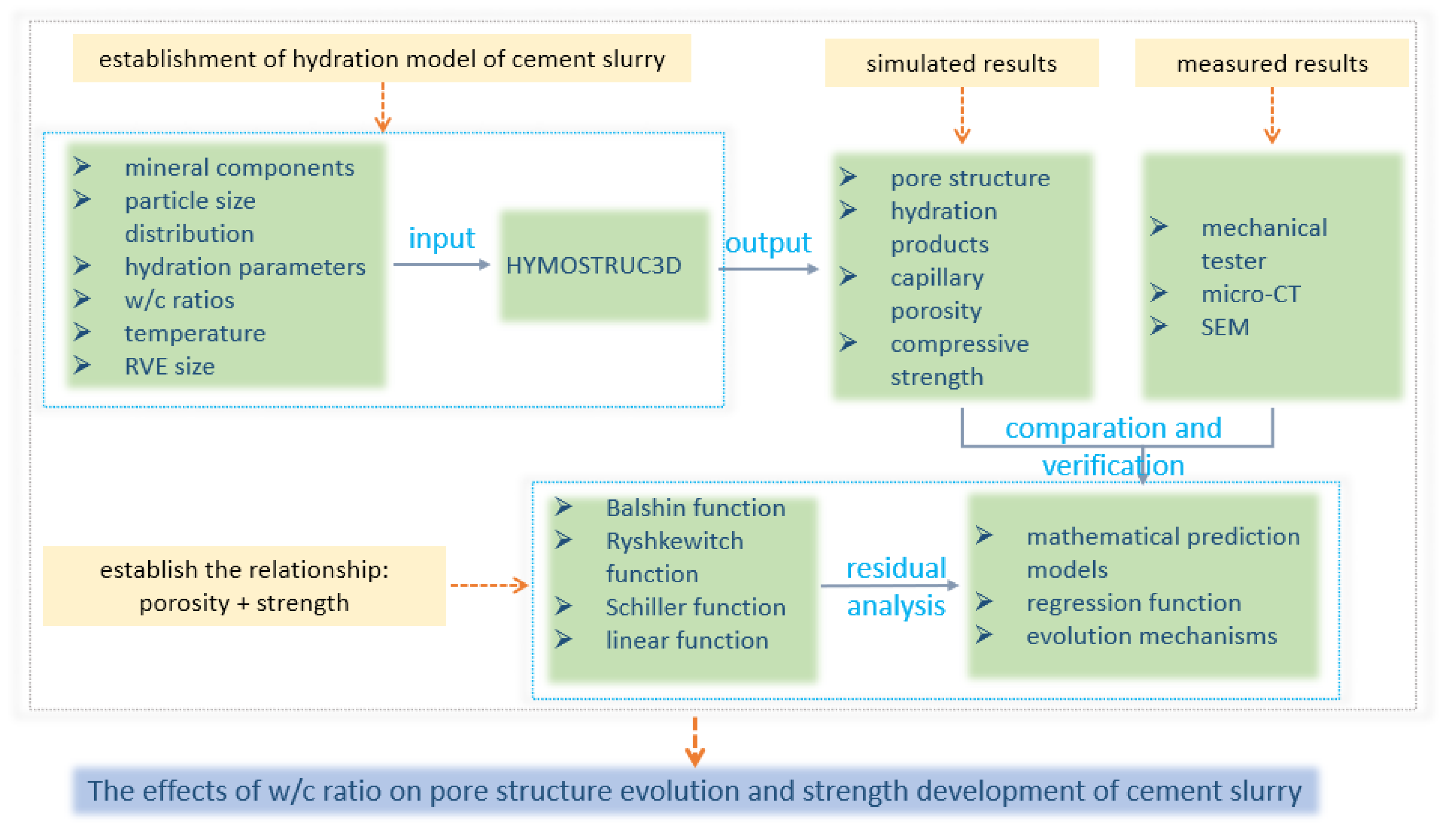

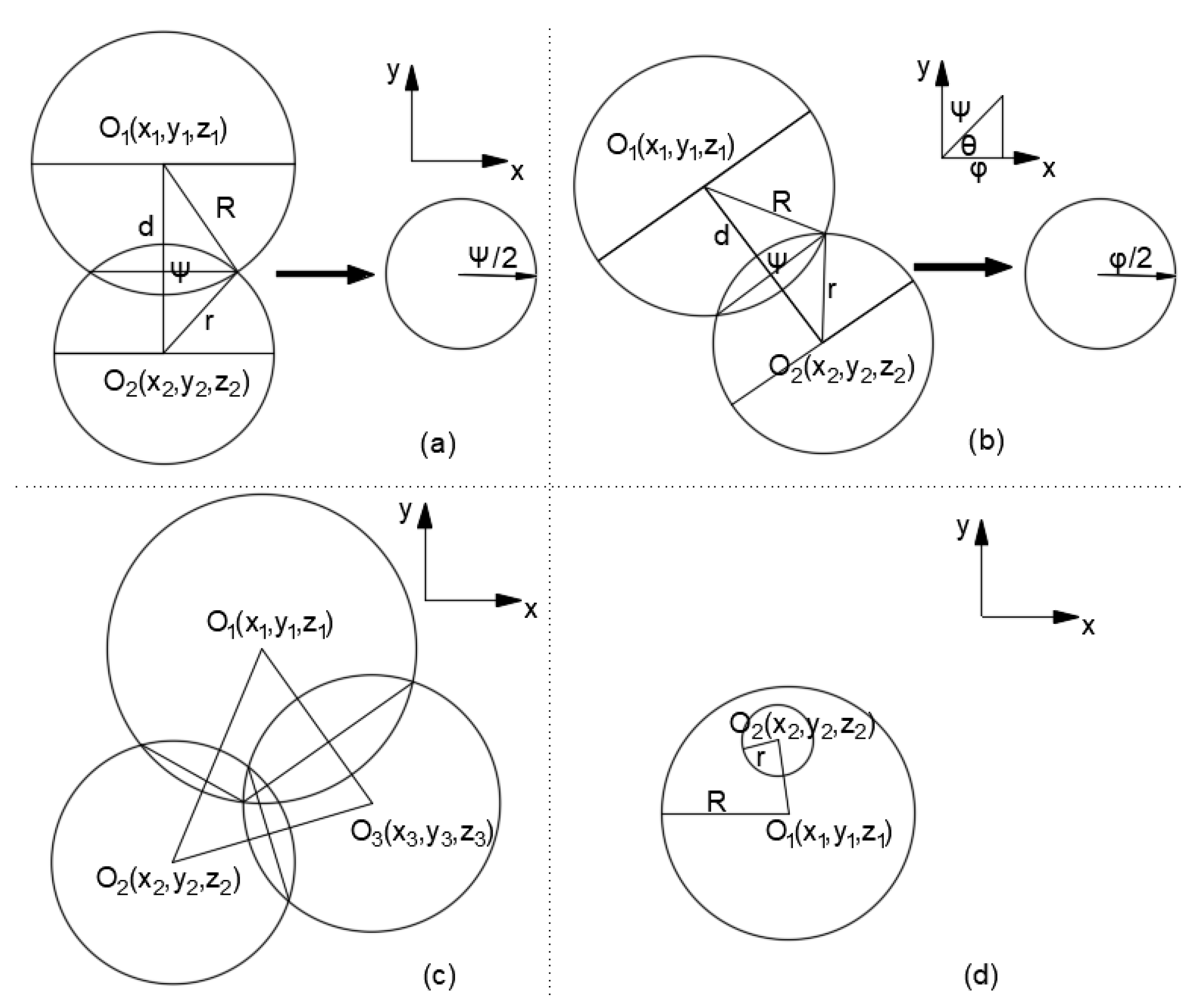
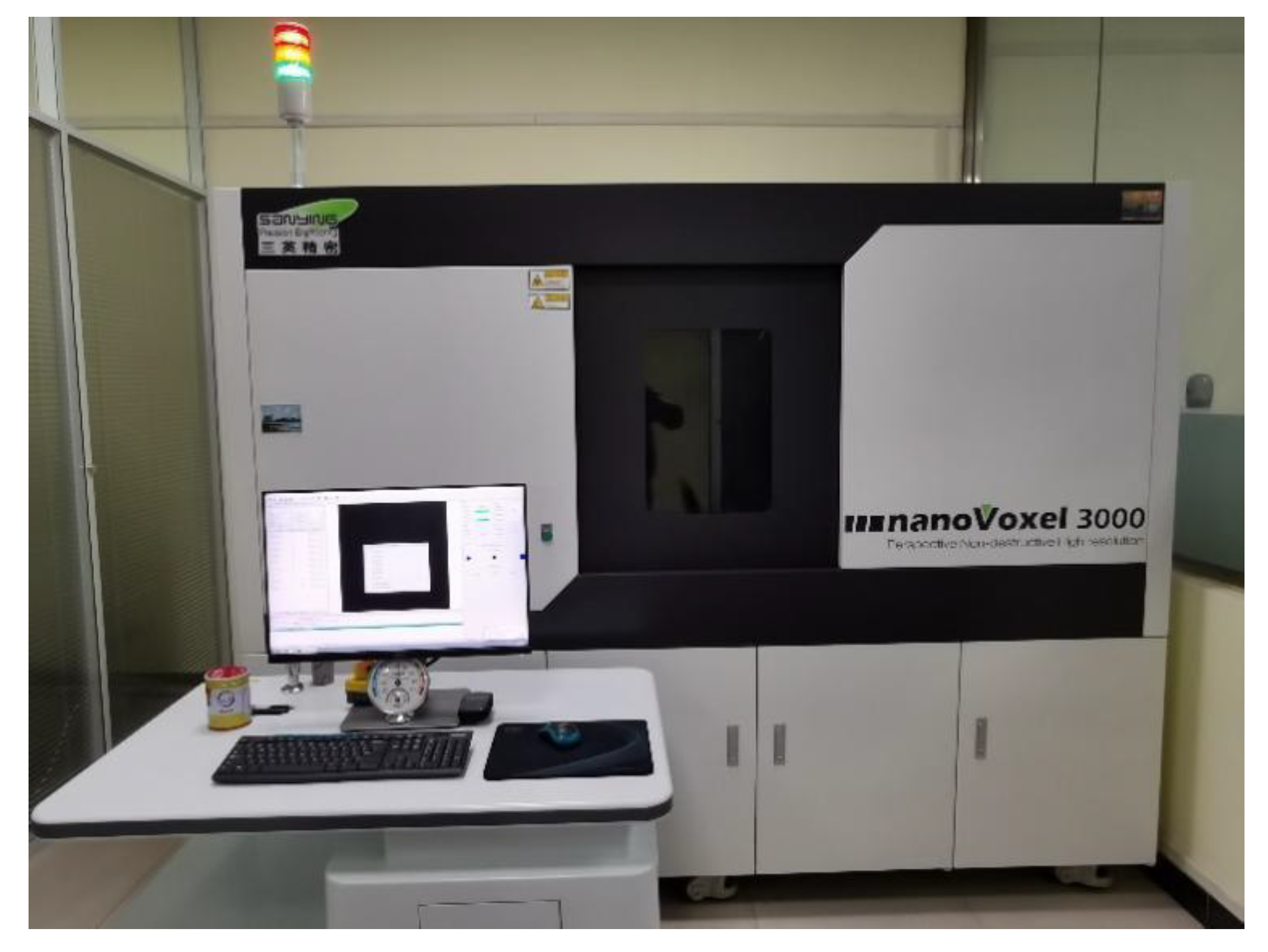
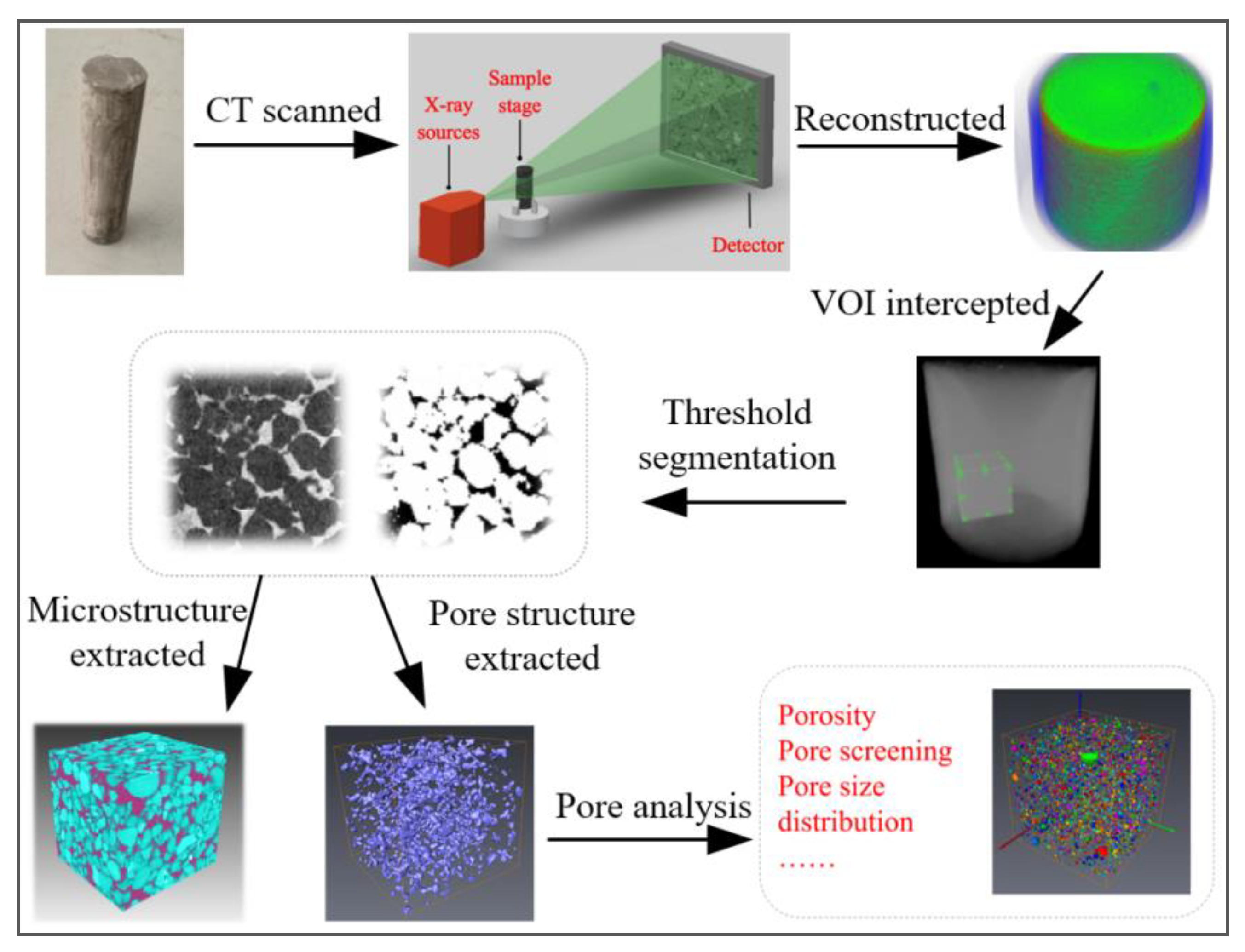

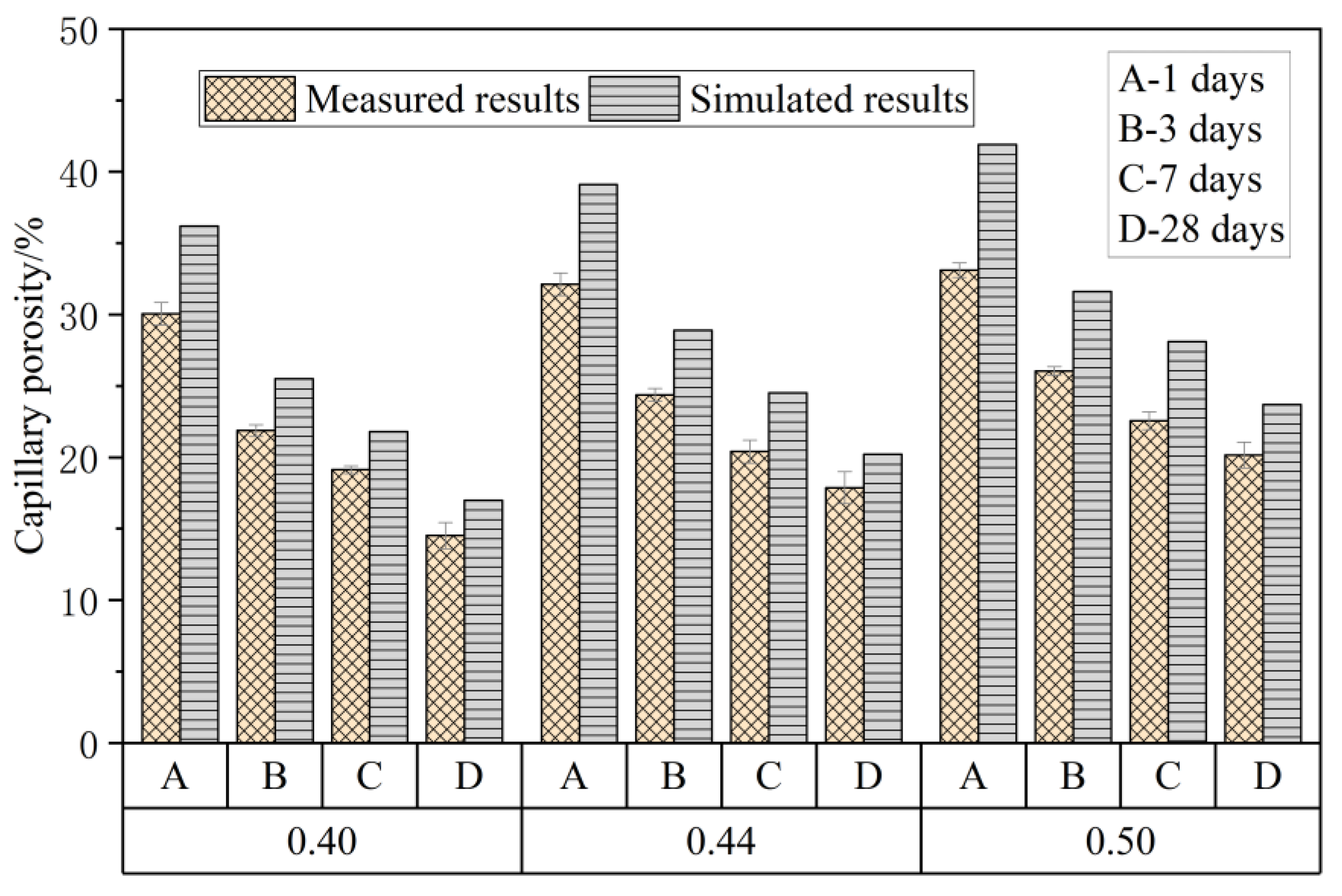

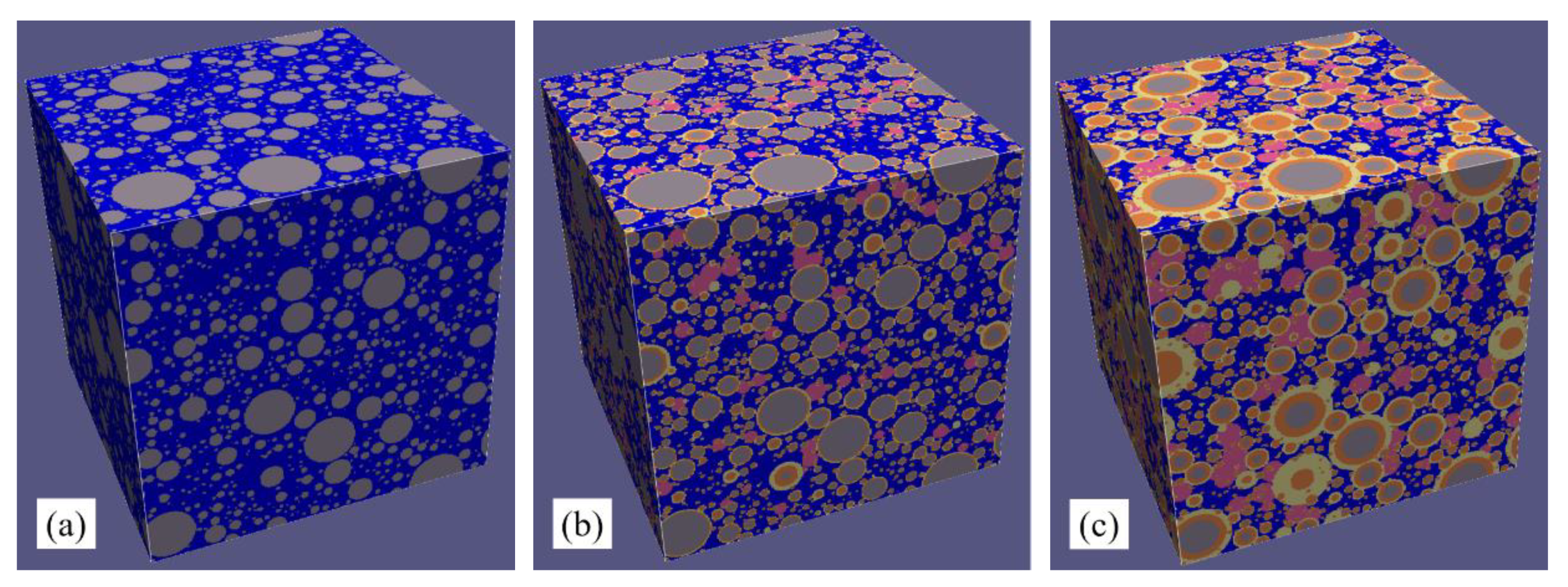
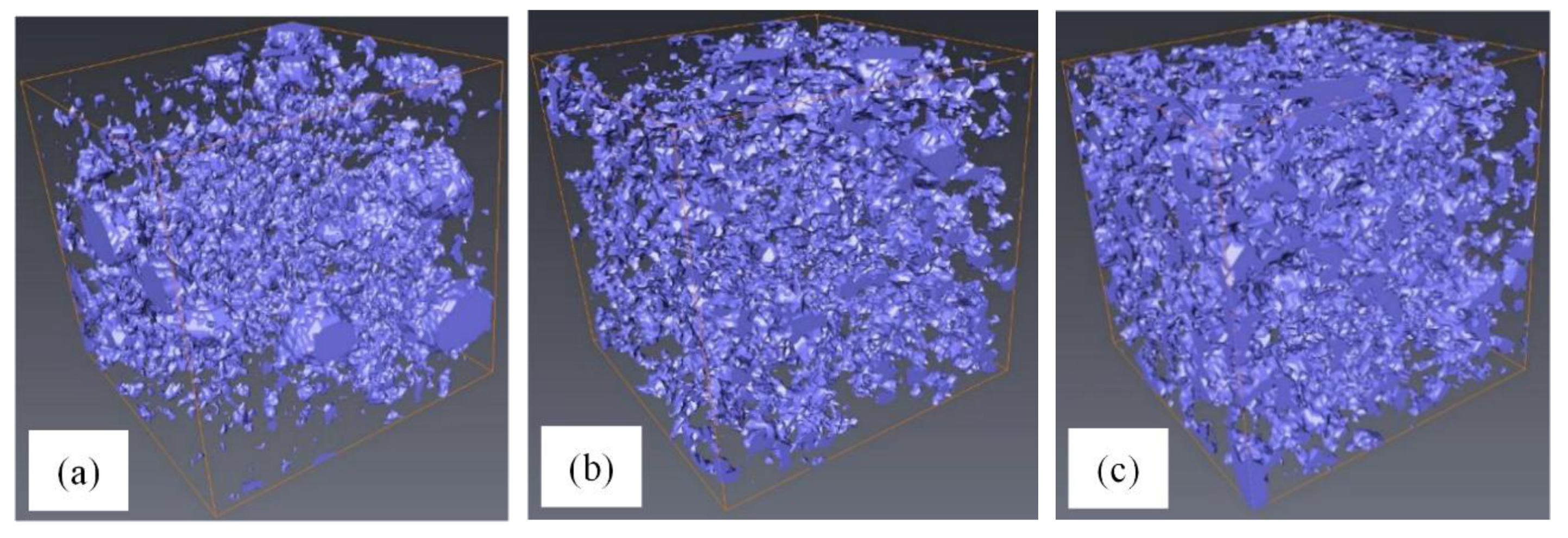
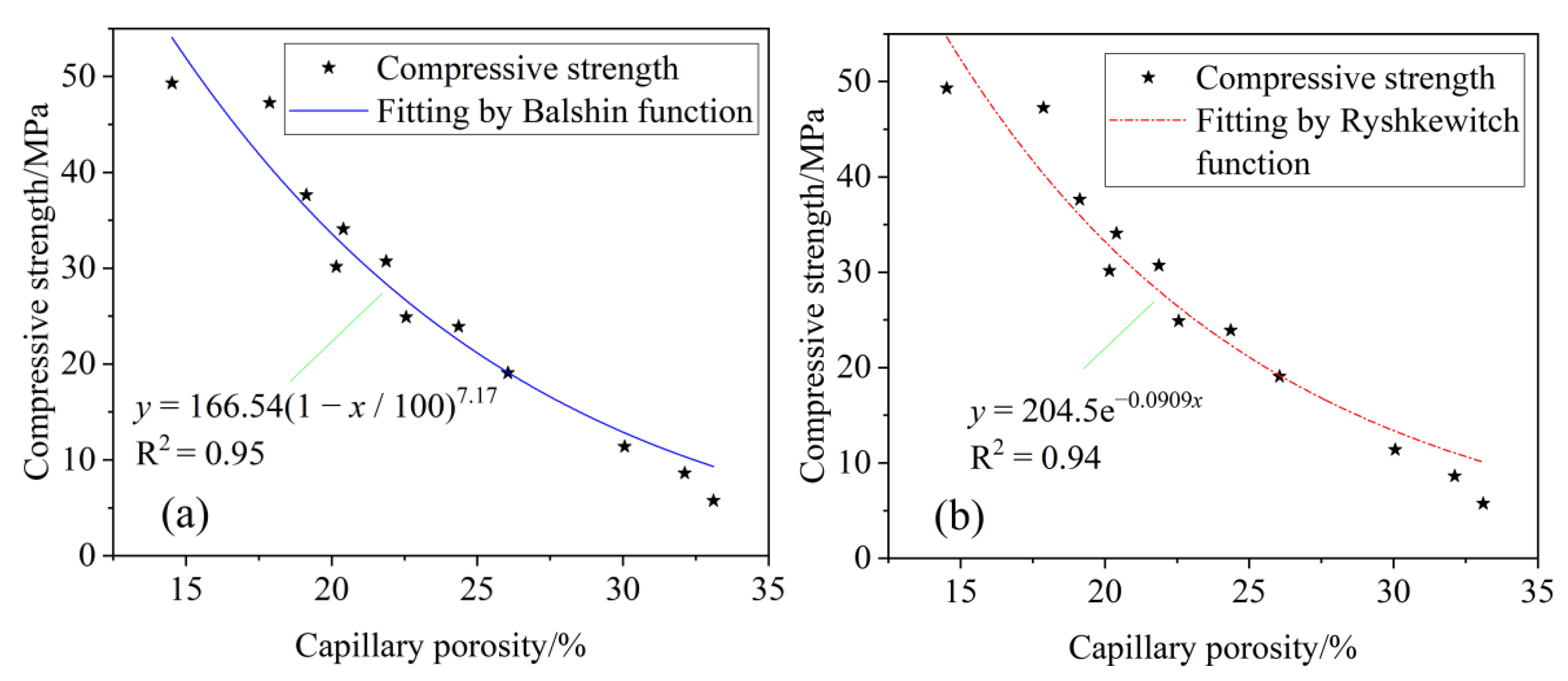
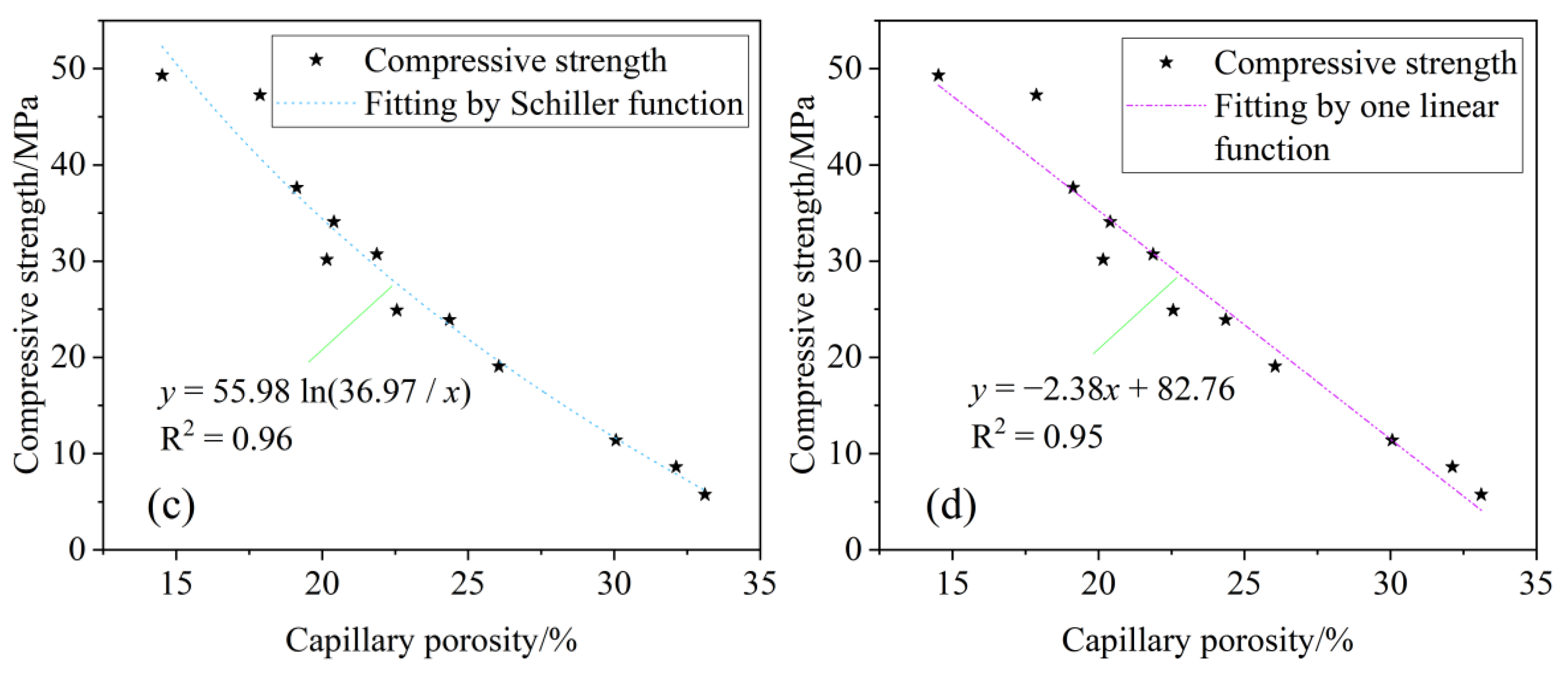
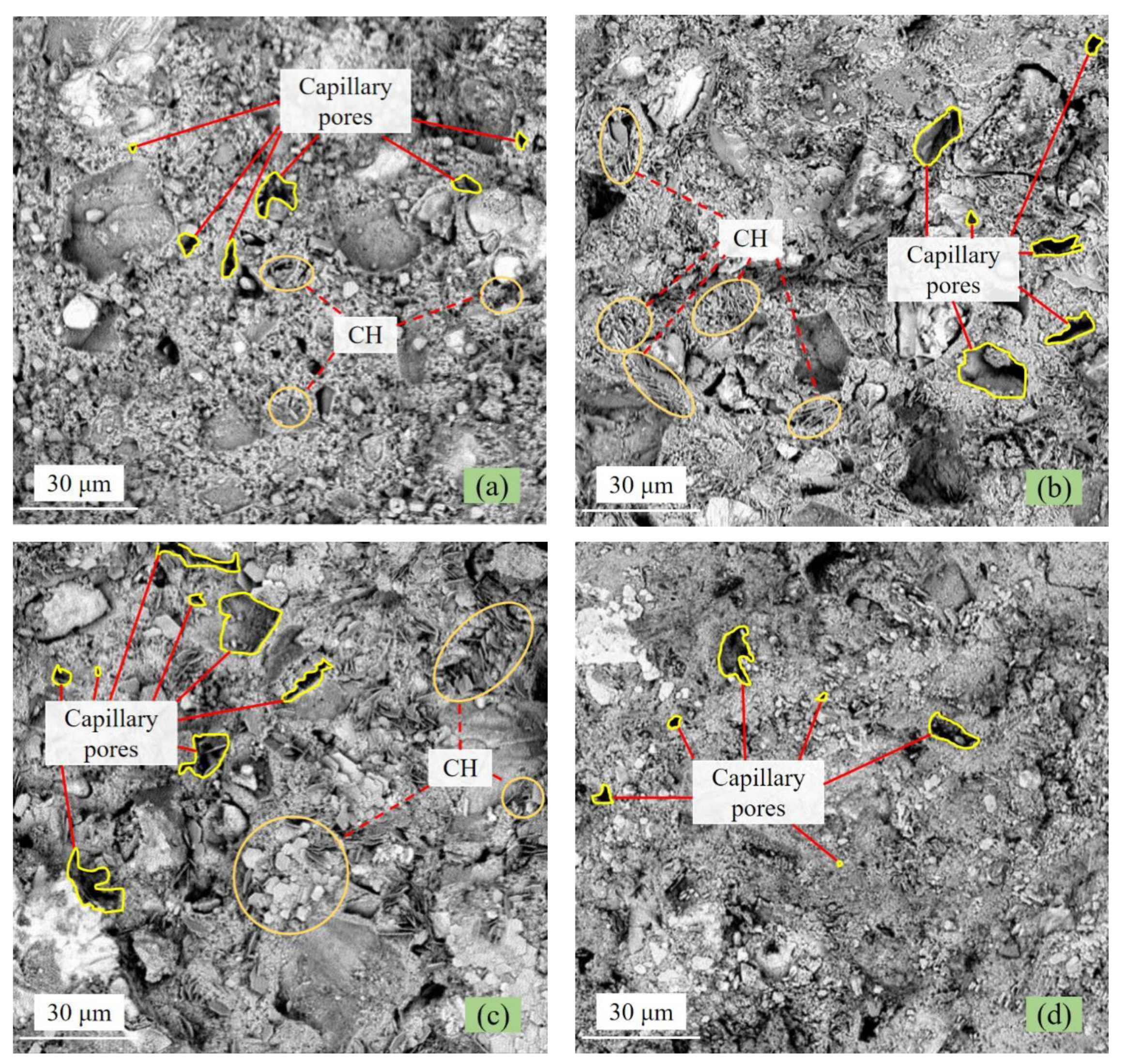
| Phase | C3S | C2S | C3A | C4AF | CSH2 |
|---|---|---|---|---|---|
| Mass fraction/% | 63.49 | 13.26 | 2.00 | 15.81 | 4.08 |
| Composition | Action | 1 | 2 | 3 |
|---|---|---|---|---|
| w/c ratio | 0.40 | 0.44 | 0.50 | |
| defoaming agent | eliminate aeration | 0.5 | 0.5 | 0.5 |
| antifiltrating agent | reduce cement slurry flitration | 6 | 6 | 6 |
| GOC | sets the cement slurry | 100 | 100 | 100 |
| Phase | C3S | C2S | C3A | C4AF | GOC | |
|---|---|---|---|---|---|---|
| Hydration parameters | K0 (μm/h) | 0.0713 | 0.0047 | 0.0644 | 0.02 | 0.0503 |
| δtr (μm/h) | 2.66 | 3.07 | 3.58 | 1.19 | 2.35 | |
| Function | Measured Results | Predicted Results | Residual | Internally Studentized Residuals |
|---|---|---|---|---|
| Balshin function | 49.30 | 54.07 | −4.77 | 2.093 |
| 47.27 | 40.60 | 6.67 | −1.714 | |
| 37.62 | 36.34 | 1.28 | −0.209 | |
| 30.15 | 33.15 | −3.00 | 0.992 | |
| 34.08 | 32.44 | 1.64 | −0.423 | |
| 30.72 | 28.38 | 2.34 | −0.744 | |
| 24.90 | 26.63 | −1.73 | 0.432 | |
| 23.91 | 22.50 | 1.41 | −0.624 | |
| 19.07 | 19.13 | −0.06 | −0.274 | |
| 11.40 | 12.83 | −1.43 | −0.033 | |
| 8.63 | 10.35 | −1.72 | −0.013 | |
| 5.74 | 9.32 | −3.58 | 0.518 | |
| 49.30 | 54.64 | −5.34 | 2.233 | |
| Ryshkewitch function | 47.27 | 40.29 | 6.98 | −1.579 |
| 37.62 | 35.93 | 1.69 | −0.264 | |
| 30.15 | 32.72 | −2.57 | 0.805 | |
| 34.08 | 32.02 | 2.06 | −0.485 | |
| 30.72 | 28.01 | 2.71 | −0.785 | |
| 24.90 | 26.31 | −1.41 | 0.291 | |
| 23.91 | 22.34 | 1.57 | −0.646 | |
| 19.07 | 19.16 | −0.09 | −0.289 | |
| 11.40 | 13.30 | −1.90 | 0.027 | |
| 8.63 | 11.03 | −2.40 | 0.095 | |
| 5.74 | 10.08 | −4.34 | 0.597 | |
| 49.30 | 52.32 | −3.02 | 1.388 | |
| Schiller function | 47.27 | 40.70 | 6.57 | −2.121 |
| 37.62 | 36.88 | 0.74 | −0.128 | |
| 30.15 | 33.95 | −3.80 | 1.424 | |
| 34.08 | 33.28 | 0.80 | −0.196 | |
| 30.72 | 29.39 | 1.33 | −0.432 | |
| 24.90 | 27.65 | −2.75 | 0.974 | |
| 23.91 | 23.35 | 0.56 | −0.241 | |
| 19.07 | 19.60 | −0.53 | 0.093 | |
| 11.40 | 11.58 | −0.18 | −0.134 | |
| 8.63 | 7.87 | 0.76 | −0.511 | |
| 5.74 | 6.17 | −0.43 | −0.116 | |
| 49.30 | 48.20 | 1.10 | 0.001 | |
| One linear function | 47.27 | 40.23 | 7.04 | −1.930 |
| 37.62 | 37.23 | 0.39 | 0.063 | |
| 30.15 | 34.78 | −4.63 | 1.564 | |
| 34.08 | 34.21 | −0.13 | 0.179 | |
| 30.72 | 30.71 | 0.01 | 0.086 | |
| 24.90 | 29.07 | −4.17 | 1.343 | |
| 23.91 | 24.78 | −0.87 | 0.272 | |
| 19.07 | 20.76 | −1.69 | 0.466 | |
| 11.40 | 11.22 | 0.18 | −0.242 | |
| 8.63 | 6.31 | 2.32 | −0.967 | |
| 5.74 | 3.96 | 1.78 | −0.835 |
Publisher’s Note: MDPI stays neutral with regard to jurisdictional claims in published maps and institutional affiliations. |
© 2021 by the authors. Licensee MDPI, Basel, Switzerland. This article is an open access article distributed under the terms and conditions of the Creative Commons Attribution (CC BY) license (https://creativecommons.org/licenses/by/4.0/).
Share and Cite
Zheng, S.; Liu, T.; Jiang, G.; Fang, C.; Qu, B.; Gao, P.; Li, L.; Feng, Y. Effects of Water-to-Cement Ratio on Pore Structure Evolution and Strength Development of Cement Slurry Based on HYMOSTRUC3D and Micro-CT. Appl. Sci. 2021, 11, 3063. https://doi.org/10.3390/app11073063
Zheng S, Liu T, Jiang G, Fang C, Qu B, Gao P, Li L, Feng Y. Effects of Water-to-Cement Ratio on Pore Structure Evolution and Strength Development of Cement Slurry Based on HYMOSTRUC3D and Micro-CT. Applied Sciences. 2021; 11(7):3063. https://doi.org/10.3390/app11073063
Chicago/Turabian StyleZheng, Shaojun, Tianle Liu, Guosheng Jiang, Changliang Fang, Bo Qu, Peng Gao, Lixia Li, and Yingtao Feng. 2021. "Effects of Water-to-Cement Ratio on Pore Structure Evolution and Strength Development of Cement Slurry Based on HYMOSTRUC3D and Micro-CT" Applied Sciences 11, no. 7: 3063. https://doi.org/10.3390/app11073063
APA StyleZheng, S., Liu, T., Jiang, G., Fang, C., Qu, B., Gao, P., Li, L., & Feng, Y. (2021). Effects of Water-to-Cement Ratio on Pore Structure Evolution and Strength Development of Cement Slurry Based on HYMOSTRUC3D and Micro-CT. Applied Sciences, 11(7), 3063. https://doi.org/10.3390/app11073063








